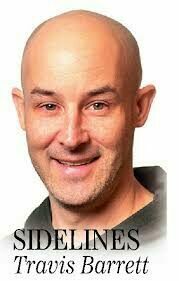SIDNEY — I’ve got the perfect pocket trip going.
Cruising down the long backstretch of a 5/8-mile track, the pounding of hooves all around me, the wind whipping through my ears. The track is wide and smooth. I’m relaxed on the reins, comfortable in the seat and enjoying the view. And then I make the mistake.
I take a look over my right shoulder to see what’s coming and OH MY GOD THERE IS A GIANT HORSE’S HEAD PRACTICALLY NIPPING AT MY COLLAR. Completely filling my field of vision, its nostrils flare and eyes widen as it bears down on me. And it is in that moment the realization comes: You can never fully experience harness racing from the fence, the grandstands at a local fair, a wagering window or the off-track betting site. If you’re going to experience the sport as it really is, you’ve got to get in the sulky and drive the horse yourself.
Or, thanks to a new initiative from the Maine Harness Horseman’s Association, you can do the next best thing. In June, the MHHA unveiled its most innovative marketing tool to date, a virtual reality headset which puts you in the a race behind a horse via a 360-degree video. Turn to the left, and see who’s coming up the rail. Turn to the right, and see what’s out there on the outside — including that fire-breathing steamroller who momentarily convinced me to take the headset off for a second to recover from the shock.
You can hear whips cracking, drivers urging their horses forward with primal, guttural screams and even the breathing of these 1,000-pound athletes. To say I worked up a sweat and felt my heart rate rise and fall with the on-track action I was flush in the middle of is not an understatement.
“It’s a different kind of exposure to the sport,” said Debbie Patterson of the MHHA, who cares for the Oculus Go Standalone Virtual Reality Headset, the fancy name for the apparatus. “The first time we took it somewhere, it was to a (Jobs For Maine Graduates) event at the end of June. There were 500 seventh-graders there, and most of the kids went crazy over it. That’s when I knew we were on to something.”
Since, the headset has made the rounds of Maine’s standardbred racetracks. It’s been to both of Maine’s commercial tracks, Scarborough Downs and Bangor Raceway. It’s also made stops at the Topsham Fair and the Skowhegan State Fair. It will be at the Union Fair next Tuesday and at the Windsor Fair for two days the following week. The goal, said Henry Jennings, the executive director of the Maine State Harness Racing Commission, is to visit all eight agricultural fairs with harness racing programs this summer and fall.
On Friday, at the training track off Drummond Road where local owner and trainer David Crochere was finishing up his work, I gave the whole VR thing a try for the first time. The setup was remarkably simple. A donated sulky and reins were attached to a portable stand which Patterson crafted herself out of some 2-by-4s and a couple of quick-release hitches. The stand, weighted down with a couple of sandbags, served as a substitute for an actual race horse.
Videos shot in 360-degree format were downloaded directly onto the Oculus Go. The entire setup, including the headset, was crafted for less than $300. The idea came from the Ohio Harness Horseman’s Association, which posted pictures of its own foray into virtual reality in the spring.
Interest at the local fairs here in Maine has been steady this summer, if not sporadic, but not because the experience doesn’t live up to the billing. Quite the opposite in fact.
“The one problem with the fairs is that when you ask if they want to try it, everybody asks the same thing,” Patterson said. “‘How much?'”
Most people don’t want to believe Patterson when she tells them it’s free. F-R-E-E. As in, hop in the seat, give it a try, no strings attached. It’s the best ride being offered an any fair this summer, and you don’t even need an over-priced wristband to get stuck at the top of the ferris wheel while the other patrons hop off on the bottom.
Patterson’s begun planning her strategy for upcoming appearances with the simulator. Too close to the race track itself, and you’re preaching to those already having an interest in harness racing. Too far out of the way, and it won’t get noticed. She’s looking for the Goldilocks position — “just right”— somewhere near the barns for those interested in farming and agriculture and young people she can turn into fans for life. Before this calendar year is out, Patterson — a photographer by trade — has designs on purchasing a camera on which she can record her own 360-degree videos. That would offer Maine harness racing fans videos recorded here in the state, using Maine horses, drivers and tracks.
Crochere said he’s never tried the simulator himself.
“I’ve done the real thing a few times,” he says, completely understated.
I feel like I have, too.
Send questions/comments to the editors.




